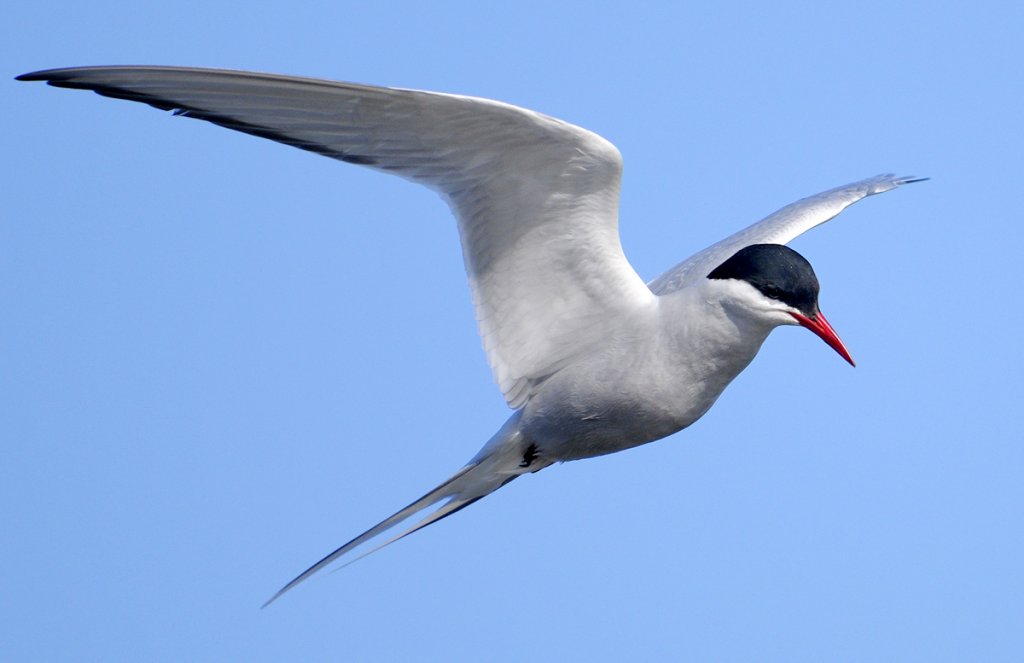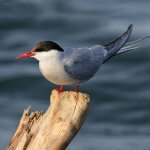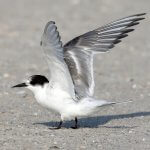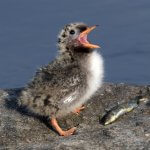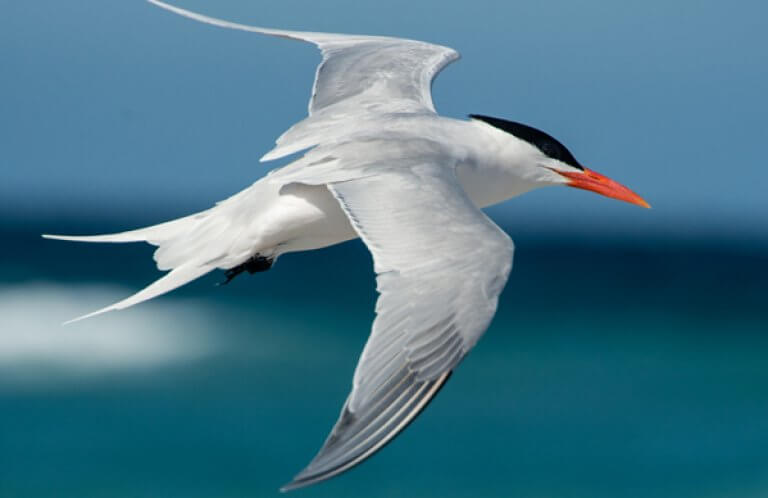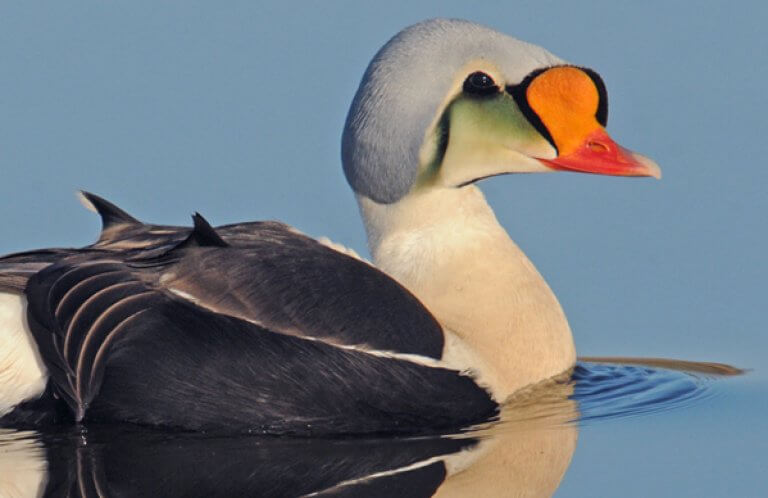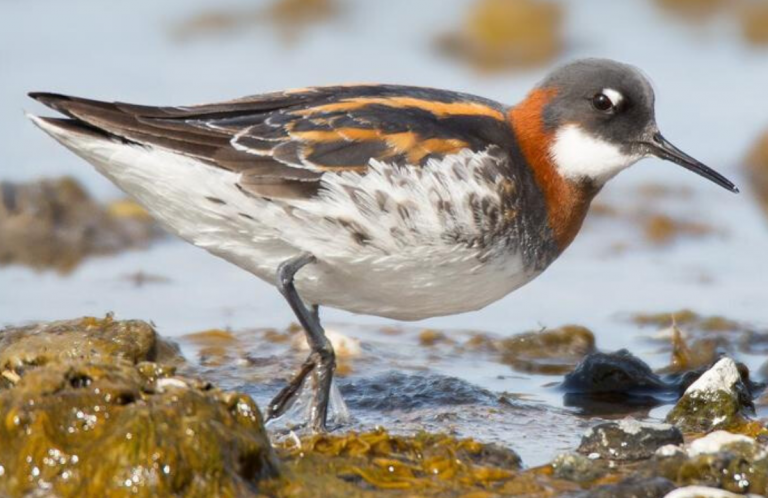About the Arctic Tern
The Arctic Tern is a dainty-looking tern, with long, narrow wings and a deeply forked tail. It's a medium-sized member of its family: smaller than a Royal Tern, but larger than the Black and Least Terns. In breeding plumage, the adult is pale gray, with a black nape and crown, white cheeks, and a long white tail. Its legs, webbed feet, and bill are bright red (the beak becomes black during the winter months). A juvenile Arctic Tern has black bill and legs and heavily barred back and wings that give it a scaly appearance. Key features to Arctic Tern ID are its noticeably short legs and bill.
This tern is long-lived, with an average lifespan of over 30 years. The oldest recorded Arctic Tern was at least 34 years old!
Chasing the Sun
The Arctic Tern has one of the longest known migration routes of any bird, flying more than 50,000 miles round-trip each year between the Arctic, where it breeds, and Antarctica, where it winters, before returning north. Although the straight-line distance between the Arctic, Antarctic, and back isn't this long, the birds don't fly in straight lines. One tracked bird was found to have flown 56,000 miles in a year. One Arctic Tern can travel an estimated 1.8 million miles during its lifetime! Most of these epic migrations take place far out at sea, out of the sight of land-bound observers.
Because it breeds under the continuous sunlight of the Arctic summer, then winters south of the equator during the “southern summer” of the Antarctic, the Arctic Tern sees more daylight each year than any other animal.
Songs and Sounds
The Arctic Tern is an especially vocal species, particularly during its breeding season. Nesting colonies resound with variety of high-pitched, shrill calls day and night. Arctic Tern nestlings even make peeping vocalizations while still in the egg!
Listen to a few Arctic Tern vocalizations below:
Alarm call, given when an intruder disturbs the nesting colony:
“Kik” call:
Flight call:
Breeding and Feeding
Noisy Neighbors
The Arctic Tern mates for life, and usually returns to the same area where it was hatched to breed. It forms large, noisy nesting colonies, often mixed in with Common Terns at more southerly nesting areas.
Couples begin courtship with a "high flight," where a female will chase her mate high into the air, then slowly descend. The male then offers fish to the female. Courtship continues on the ground and in the air, with the couple strutting and flying around each other. During this time, the male also brings food to his prospective mate.
After mating, a pair chooses their nest site, usually on the ground, and constructs a simple scrape, where the female lays 2-3 brownish-olive eggs. Both male and female are attentive parents, taking turns incubating their eggs and brooding hatchlings. Hatchlings stay with their parents for about three months before they venture off on their own. Young Arctic Terns begin to breed at three to four years of age.

This tern vigorously defends its nest and territory from potential predators, noisily dive-bombing and striking intruders with their sharp bills, even to the point of drawing blood. Other Arctic-breeding birds such as the King Eider, Red-necked Phalarope, and Ruddy Turnstone will nest near Arctic Tern colonies to benefit from their aggression.
Fish-Feeder
Like most of its relatives, the Arctic Tern dines mainly on small fish, supplemented by crustaceans, insects, and aquatic larvae. It is largely a surface feeder, taking its prey by shallow plunge dives, dipping from the water's surface, or hawking for flying insects. At sea, it often associates with schools of predatory fish or marine mammals that drive prey to closer to the water's surface. Although the Arctic Tern often forages by itself, it will join larger flocks of terns or gulls to feed. Ever the opportunist, this species will steal fish from other birds whenever it can.
Region and Range
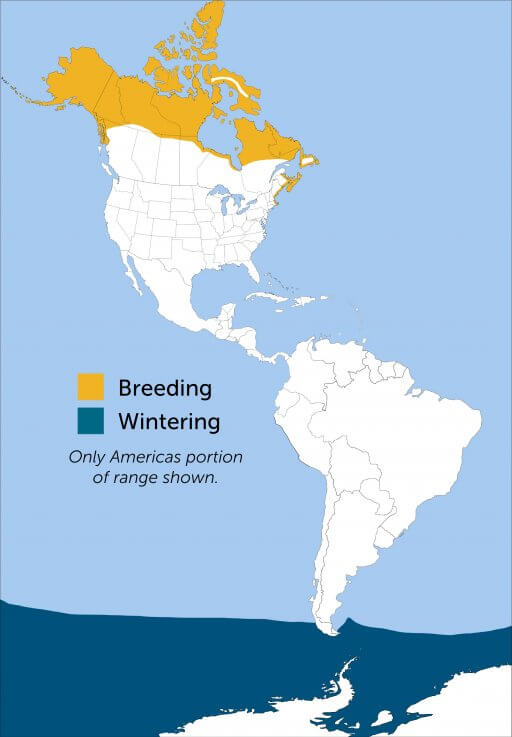
The Arctic Tern breeds across Arctic and sub-Arctic regions of Canada, the United States, Europe, and Asia. It winters all around Antarctica, along pack ice and at sea. Its epic migrations take place far out at sea, and this species is rarely sighted from land outside of its breeding season.
Conservation of the Arctic Tern
In North America, Arctic Tern populations were hit hard by slaughter for the plume trade during the nineteenth-century. Although that trade is defunct, some human populations still collect their eggs for food, which can impact local populations. Some illegal trapping also continues.
Habitat loss caused by climate change threatens low-lying areas within the Arctic Tern's breeding grounds. This bird is very sensitive to disturbance at nesting colonies and may abandon them if disrupted too often.
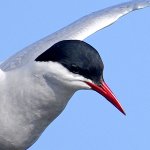
Help support ABC's conservation mission!
Egg and chick predation by gulls and invasive predators such as cats is another threat to the species. Overfishing impacts the Arctic Tern's most important food sources, and foraging terns are at increasing risk of ingesting plastics. Environmental pesticides may reduce availability of its insect prey. Migrating terns risk collision with offshore wind turbines.
A number of ABC programs address these threats. ABC's Fisheries program encourages new technologies, policy changes, and consumer action to face challenges to the Arctic Tern and other seabirds posed by this industry. Our Bird-Smart wind energy program is working to reduce bird deaths resulting from wind energy development, and our Conservation Advocacy team tackles other human-caused threats to the Arctic Tern, ranging from cats to pesticides.
Get Involved
Policies enacted by the U.S. Congress and federal agencies have a huge impact on seabirds. You can help shape these rules for the better by telling lawmakers to prioritize birds and bird-friendly measures. To get started, visit ABC's Action Center.
Plastics pose a deadly threat to seabirds around the world. You can help seabirds by reducing your daily use of plastics. To learn more and get started, visit our Plastics page.
American Bird Conservancy and partners are creating predator-free nest sites for vulnerable seabird species, reducing fishery impacts, and much more. This is a monumental undertaking, requiring the support of many, and you can help by making a gift today.





































